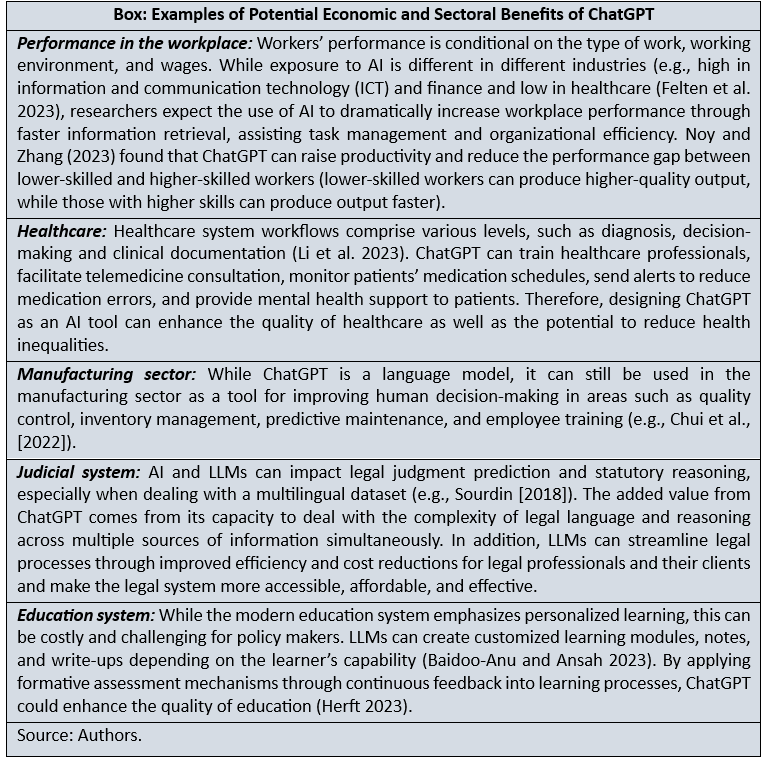
ChatGPT is a generative artificial intelligence (AI) technology, launched on 30 November 2022 by US firm Open AI, with the potential to lay the foundation for structural change and economywide productivity growth. The technology is part of the generative pre-trained transformer family of language models, with the ability to efficiently respond to user queries across multiple knowledge domains, reaching 100 million users globally by January 2023. While it could alter the landscape for learning and knowledge creation, helping to tackle global policy challenges on sustainable development, informed decision-making by human users in the application of ChatGPT is central to maximizing the tool’s capacity to boost economic prosperity and well-being. The evolution and roll-out of ChatGPT to date have been rapid. Its optimal utilization for society requires a deeper understanding of its capabilities and effective safeguards in place to mitigate potential risks, uncertainties, and misuse.
Understanding technological change and its effects on economic progress from a historical perspective can be traced back to the work of Landes (1969), Rosenberg (1982), and Mokyr (1992). Seminal works in macroeconomics by Solow (1956), Romer (1990), Grossman and Helpman (1991), and Aghion and Howitt (1992) stressed the central role played by technological advancement for productivity, competitiveness, and economic growth. Economists generally perceive technology as an efficiency enhancer, even in the case of the absence of uniformity across regions and industries or over time. Policy makers face the dilemma of predicting whether a new technology will become a so-called “general purpose technology” ex ante, its impact on the previous dominant technology choice, and devising policies either preventing or incentivizing certain types of stakeholder behavior (e.g., by firms or individuals).
It is commonly accepted that continuous innovation and heuristic methods of adopting AI positively affect economic growth and productivity, especially where AI complements existing workers rather than completely replacing them (e.g., Acemoglu and Restrepo [2020]; Kleinberg et al. [2018]). That said, policy formulation can be complex, underpinned by uncertainty and whether new technologies can sustainably and safely replace pre-existing technologies. Researchers expect AI to stimulate rapid advancement across sectors, including through management practice adjustments (e.g., Giraud et al. [2022]; Kolbjørnsrud et al. [2016]). Although AI is still at a nascent stage, increased attention from both users and critics calls for a comprehensive assessment of its impact on productivity, economic performance, and the welfare of society.
Benefits of ChatGPT
By conditioning on appropriate prompts, large language models (LLMs) can solve a variety of natural language processing (NLP) tasks with “zero shot”—i.e., without relying on any training data for a given downstream task (Brown et al. 2020, Chowdhery et al. 2022). ChatGPT offers relatively advanced zero-shot learning compared to other LLMs, with scope for gains across a variety of sectors (see Box).

ChatGPT and other LLMs: What are the risks?
Uncertainty of outcomes in conjunction with the speed of development has led to a general apprehensiveness toward AI throughout its history, as in the case of ChatGPT and other LLMs. A major concern pertains to the size and quality of the underlying training dataset. A BBC Science Focus article indicates that the model was trained using 570 GB of data, relative to 64 zettabytes of real-world data. Therefore, the size of the underlying training data and their representativeness are causes of concern that could affect the accuracy of probabilistic answers generated by LLMs. In addition, although predictive analysis by LLMs on the basis of historical data is possible, such outcomes should be assessed with caution.
As a machine, AI is unable to replicate emotions and soft skills. A high degree of reliance on LLMs would alter the behavior of the social system, such as what was experienced in the education system during the COVID-19 pandemic. Instead of emphasizing strong fundamentals, a learner may rely more on the solution provided by the machine and eventually fall behind in the development of creative ideas and innovation capabilities. Similarly, demand for skilled personnel could call for replacing a worker lacking a willingness to learn, while some firms could operate otherwise by hiring the same worker at a cheaper cost and relying more on the machine. This would have long-run implications on labor market dynamics. An optimal outcome could be reached by using AI to enhance existing human capabilities, maximizing potential output and productivity gains, rather than mimicking human intelligence. It can be argued that the latter would worsen inequality in wealth and income (e.g., Brynjolfsson [2022]).
Another major concern of ChatGPT is the scope for outcomes based on heterogeneous sources, potentially mixing facts and fiction. The reluctance of ChatGPT to provide sources of information makes it difficult for output to be verified. Moreover, there is a growing tendency among users to use ChatGPT content without verifying its authenticity, leading to potentially drastic consequences if used on the basis of expert advice and guidance. In addition, there are concerns that ChatGPT could be used in an unethical way, such that users of the tool could claim that the output is based on their own intelligence and not AI-generated output, e.g. knowledge products by researchers. Related to this, many schools and higher education providers globally have restricted the use of ChatGPT, citing disruption to critical-thinking and problem-solving skills and potential for improper use, including across several universities in Japan. More broadly, the race to market by AI providers around the world before understanding the impact, particularly on vulnerable segments of society and culture, points toward a need for appropriate regulatory action by policy makers. Indeed, citing risks to society and humanity and a need for a deeper understanding of how to use AI in a manner whereby the outcomes are positive and risks can be effectively managed, the Open Letter by the Future of Life Institute on 22 March 2023 called for all AI labs to pause for at least 6 months on developing systems more potent than GPT-4. The letter was signed by prominent AI researchers, as well as leading figures in the tech industry, including Elon Musk, Steve Wozniak, and Yuval Noah Harari. Moreover, some countries have taken more extreme measures, with Italy banning ChatGPT on 31 March 2023, citing privacy concerns.
The way forward
There is no doubt that ChatGPT as an LLM can underpin generational technological change, with the potential to contribute substantially to economywide productivity and sustainable economic growth. However, the use of the technology to replace humans limits its potential, while the scope for misuse and misinformation poses risks for society more broadly. A deeper understanding of the implications is needed by both AI developers and policy makers. While ChatGPT has the potential to catalyze structural change in the economy, its rapid pace and impact of roll-out since November 2022 call for a careful and comprehensive stocktake of its capabilities. This will help to underpin effective AI governance, regulation, and risk mitigation such that AI can safely and robustly complement and expand human capabilities in knowledge creation and application, thereby maximizing its potential for positive outcomes on sustainable development.
References
Acemoglu, D., and P. Restrepo. 2020. Robots and Jobs: Evidence from US Labor Markets. Journal of Political Economy 128 (6): 2188–2244.
Aghion, P., and P. Howitt. 1992. A Model of Growth Through Creative Destruction. Econometrica 60(2): 323–351.
Baidoo-Anu, D., and L. O. Ansah. 2023. Education in the Era of Generative Artificial Intelligence (AI): Understanding the Potential Benefits of ChatGPT in Promoting Teaching and Learning. SSRN.
Brown, T. B., et al. 2020. Language Models Are Few-Shot Learners. In Advances in Neural Information Processing Systems (NeurIPS). OpenAI.
Brynjolfsson, E. 2022. The Turing Trap: The Promise & Peril of Human-Like Artificial Intelligence. Dædalus, the Journal of the American Academy of Arts & Sciences 151(2): 272–287.
Chowdhery, A., et al. 2022. PaLM: Scaling Language Modeling with Pathways. Google Research.
Chui, M., R. Roberts, and L. Yee. 2022. Generative AI Is Here: How Tools Like ChatGPT Could Change Your Business. Quantum Black AI by McKinsey, Commentary, December.
Felten, E., R. Manav, and R. Seamans. 2023. How Will Language Modelers Like ChatGPT Affect Occupations and Industries?
Giraud, L., Z. Ali, S. Hernandez, and A. A. Akram. 2022. The Impacts of Artificial Intelligence on Managerial Skills. Journal of Decision Systems.
Grossman, G. M., and E. Helpman. 1991. Trade, Knowledge Spillovers, and Growth. European Economic Review 35(2-3): 517–526.
Herft, A. 2023. A Teacher’s Prompt Guide to ChatGPT Aligned with ‘What Works Best’. In AI in Education: Incorporating GenAI into Teaching. University of Wollongong, Australia.
Kleinberg, J., H. Lakkaraju, J. Leskovec, J. Ludwig, and S. Mullainathan. 2018. Human Decisions and Machine Predictions. Quarterly Journal of Economics 133 (1): 237–293.
Kolbjørnsrud, V., R. Amico, and R. J. Thomas. 2016. How Artificial Intelligence Will Redefine Management. Harvard Business Review, November.
Landes, D. S. 1969. The Unbound Prometheus Technological Change and Industrial Development in Western Europe from 1750 to the Present. Cambridge University Press.
Li, et al. 2023. Will ChatGPT Transform Healthcare? Nature Medicine 29: 505–506.
Mokyr, J. 1992. The Lever of Riches: Technological Creativity and Economic Progress. Oxford University Press.
Noy, S., and W. Zhang. 2023. Experimental Evidence on the Productivity Effects of Generative Artificial Intelligence. MIT Working Paper, March.
Romer, P. M. 1990. Endogenous Technological Change. Journal of Political Economy 98(5) Part 2: S71–S102.
Rosenberg, N. 1982. Inside the Black Box: Technology and Economics. Cambridge University Press.
Solow, R. M. 1956. A Contribution to the Theory of Economic Growth. Quarterly Journal of Economics 70(1): 65–94.
Sourdin, T. 2018. Judge v Robot? Artificial Intelligence and Judicial Decision-Making. UNSW Law Journal 41(4): 1114–1133.









Comments are closed.